Food that is organic or not organic? Grown from genetically modified (engineered) seeds or not?
How about neither genetically modified nor organic? What about both organic and genetically modified??
The first two are pretty common questions, while the latter two are almost never asked. Some people believe that within the continuum of macro and micro phenomena of the natural world, deliberate and precise crop modifications at the genomic level should be prohibited, must be linked to pesticide use, and are distinctly different than the relatively random modifications achieved via traditional breeding techniques. They are virulently anti-biotechnology. A whole industry developed around these beliefs.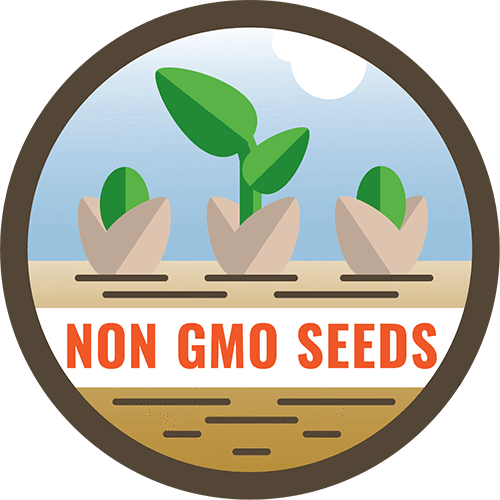
This limited thinking comes at a cost: We spend a greater proportion of income on food; we omit some foods out of the diet due to cost, possibly reducing nutrient quality intake. In Canada, where I live, we risk becoming a laggard nation by signaling to the pubic and businesses that we are not willing to keep up with technology; and inadvertently or note we perpetuate fear mongering agendas to result in an ignorant population.
Here’s a question I’ve struggled with for a long time: why are those that are pro-organic and concerned around pesticide use also not embracing GMO technology, which in some cases dramatically reduces the amount and toxicity of crop chemicals?
I believe “organic GMOs” should be not only accepted but actively pursued and especially by those who embrace the goal of organics to reduce the environmental impact of farming.
I know that assertion seems absurd to most people but I’m going to try to explain my perspective. Keep in mind there are many layers to this topic, some outside the scope here, but I’m going to try to clearly break it down step-by-step.
What is organic, really?
Almost all of the plant food you eat was processed from commercial crop varieties. Of the dozens of varieties registered and available in any given year, a farmer must then assess performance of that variety (either from past experience, or from accumulated field trial data provided by researchers), consider if the data is relevant for the farm’s geography/soil/latitude, as well as seed availability, production economics, and other production implications, while staying aware of what market demands are while usually trying to predict what prices will be in the coming year. For example (and assuming prices aren’t contractually locked-in with a buyer prior to producing it), does the buyer of his grain want certified organic grain or not? This question in particular is relevant since production practices of the crop in the field are largely determined by those intended markets, especially in terms of the land being used as well as pesticides used.
Think about the chronological order of everything described so far. The way the crop is grown in the field determines whether or not the food made from it can be labelled as “organic” or not. “Non-GMO” is dependent upon the way the genetics came together prior to variety registration, years before the variety is grown in the field. Yet, the terms “organic” and “non-GMO” are used interchangeably and inseparably.
Why?
Here’s an analogy. Let’s say you’re shopping for a new sports car, and your only “must-have” is that it must be powered by a BMW engine. Logically, it would make sense to start looking at BMW cars, but actually you can get other brands with BMW engines: Morgan (brand) out of the UK is a distinct brand but actually uses BMW engines:
Morgans also happen to be mostly hand-built, use wooden body panels, and their factories are mostly old brick buildings. BMW uses much automation/robotics and their factories are more modern and constructed differently. If your only must-have is the BMW engine, do you really care how the car around it was produced? Probably not.
This analogy can help us understand the controversy over growing GMO seeds organically. A widely-held but inaccurate perception of agricultural practices / food production is that they must be either one or the other of these two categories:

But this is a more accurate way of viewing it:

In other words – and in most cases – the method of production (growing the crop) used in the field is independent of the method used to establish the genetics of that plant (from which the food or ingredients are sourced). What is more, the way that the genetics were assembled in the crop must always precede production of the crop commodity that later becomes food.
Because the genome – all genes of the plant – is the “blueprint” for the plant, genetic changes can influence a huge diversity of traits, including (but not strictly or limited to) things like herbicide (such as glyphosate) tolerance. Conversely, not all herbicide tolerance is the result of “genetic modification” techniques either.
One disclaimer. I have worked for one of the “big companies” — and I have also worked in government alongside incredibly smart people that were not secretly funded by an agricultural biotechnology company contrary to what some camps ceaselessly believe. Neither of those groups have any interest in talking about this topic. Guess why? Because there’s no money in it. That’s only half an answer though, because profit in a capitalist market is the by-product of supplying a demand with a desired – and affordable – product…a product that consumers – you and me – are willing to pay for.
So to ask the question again: Why don’t private companies or government have an interest in talking about “organic GMOs”? It’s because there’s zero demand. But why is there zero demand? I think it’s because consumers are completely unaware that it’s even a theoretical option and thus nobody is asking for such products. In my opinion, organic GMOs have massive potential: to improve nutrition, minimize pesticide use, quickly mitigate production challenges related to climate change, increase carbon sequestration and minimize environmental damage of climate change, reduce costs along the value chain (thus reducing cost of groceries), open up an entire new branch of research, and employ highly-skilled people.
Venn diagram analysis
I’m going to use a weird-looking square version of a Venn diagram to avoid awkward gaps between boundaries of overlapping circular borders of a normal Venn. I’m going to start broad, then increasingly narrow down the details, adding layer upon layer in the diagram. There will be 3 major “layers” to this process as well:
- Origins
- Breeding and variety development
- Field production
1) Origins
Unless an entire genome has been synthetically assembled de novo (by manually connecting millions of independent nucleotides and inserting it into an empty cell resulting in a viable life form)… or, by manually editing codons of an existing genome with alternative sequences with the same function… or, unless a living organism has somehow spontaneously manifested itself out of the “aether,” any organism – plant or animal, “organic” or not – must be derived from existing genetics. In other words, in plants, “parent” genetics have to come together and produce the next generation. For the sake of this post, I’m going to represent this starting “pool” of genetics using a giant grey square:
This is the first major “layer’ to this discussion. So again, this grey square blob contains all the compatible genetics in nature that could possibly be combined and recombined to produce the baby plants of the next generation. (The label at the top refers to two differing and naturally-occurring plant reproductive systems, but regardless, this square still represents all available genetics). In the case of GMOs, cisgenic sources would be grouped into this pool. I didn’t show it here because this illustration will become really busy as it is already, but transgenic would be a small, different shade of grey square off to the side (since those genetic modifications do become compatible but technically come from a non-compatible source organism, and make up a very small proportion of all genetic material available.
2) Breeding and variety development
Next, let’s look at the 2nd major layer to this process (As we move inwards towards the centre of this diagram, we’re moving further along the breeding process, step by step, until we reach the new plant variety. (The letters A, B, C and D refer to various routes to get to that end point, which I’ll summarize at the end, but for now just ignore them). Note that sizes of any category are not necessarily proportional to the real amount of material established through either method, it’s just to illustrate the relationships.):
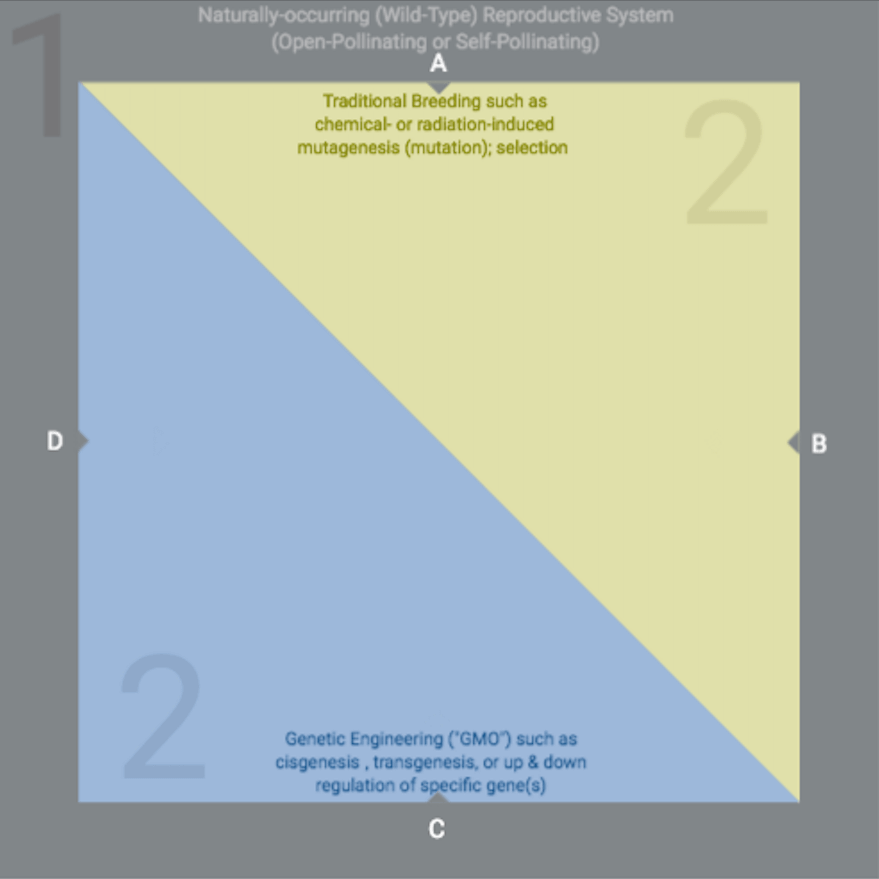
Since the grey represents any and all possible genetic resources from which the genetics of a new plant variety can be established, any technique, whether it’s traditional breeding, or “GMO,” must be derived from those resources. Those genetic resources used, regardless of the methods, are thus a sub-set of that whole pool of resources available. During this process, tools to enhance the breeding process, such as MAS described earlier, may be used. (Another example might the general category of gene-editing, including techniques such as CRISPR, which are not consistently considered GMO across all regulatory jurisdictions at this time.)

Even though a plant may be the recipient of novel genes, or of engineered changes within its existing genome, these still make up a very small percentage of the entire genome of the plant. Therefore, selection must still be carried out in the field as it would be with traditional breeding. A GMO is not a completely unnatural, 100% fabricated or synthetic thing; it is actually a “mostly-the-same” variant of the non-GMO counterpart.
Let’s look at Brassica napus, for example. This oilseed crop has 848,200,303 total nucleotide base pairs (the subunit of genes, and the level at which modifications can be engineered) and a large proportion of varieties in North America are “GMO.” Now let’s compare a GMO version of Brassica napus, an InVigor™ variety: one transgene enables it to be unaffected by a herbicide called glufosinate, and a second one that influences fertility in the plant. The former is comprised of 171 base pairs, the latter of 90 base pairs. In total, these GMO alterations – relative to the wild type progenitor – account for 0.00003077% difference. I’d argue the proteins expressed by the genes should be the focus of any opponent to such technologies, but even those products of the modifications are a minuscule proportion of total expression in the plant.
The lighter shading here represents the breeder selection for traits, such as that glufosinate tolerance, or something as straightforward as the height of the plant. Since any breeding program has multiple generations of populations at any given time, there’s a lot of ‘back and forth’ as far as activities go, but this depicts the progress further towards the end goal of establishing a variety:
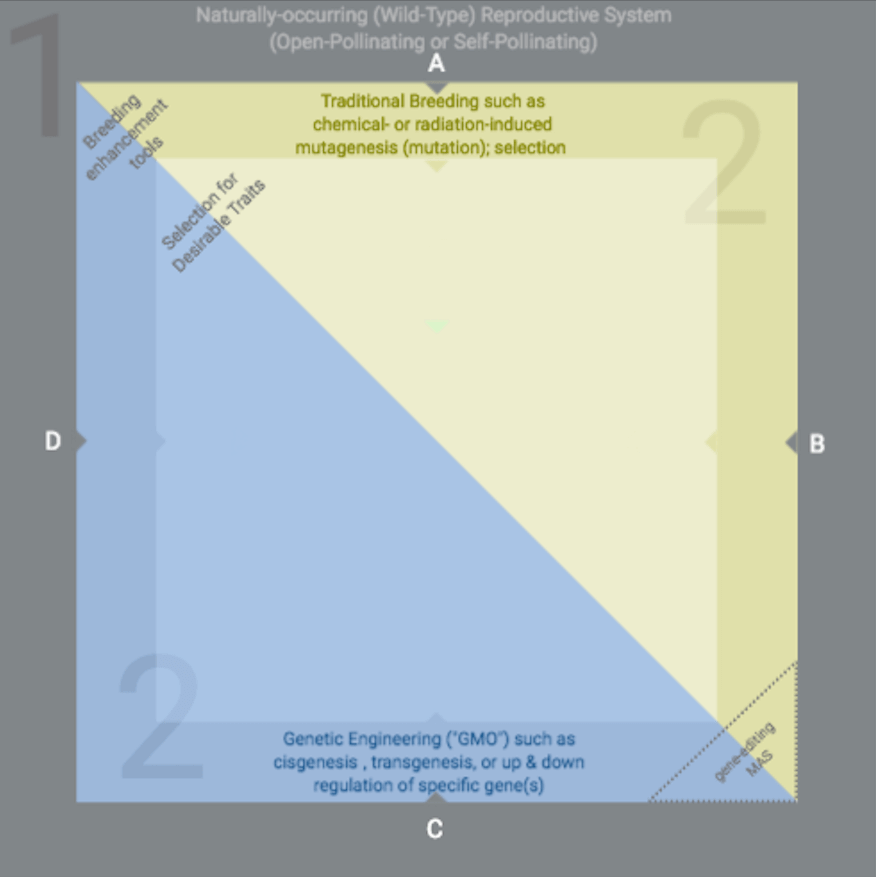
These activities will be pretty much the same regardless of whether or not “GMO” techniques have been used, since as mentioned, GMO is not an entirely new thing, it is mostly the same as a non-GMO variant and must still be grown in the field like any other plant. Aside from the new trait(s) of a GMO that result from novel genes introduced, the GMO variant will respond to environmental pressures the same as any other version of it will. A few common traits selected for are highlighted below (the dotted outlines represent particulars that may be regulated differently in different jurisdictions, can can’t be considered “definitely” a traditional or a GMO tool/process, technically speaking):
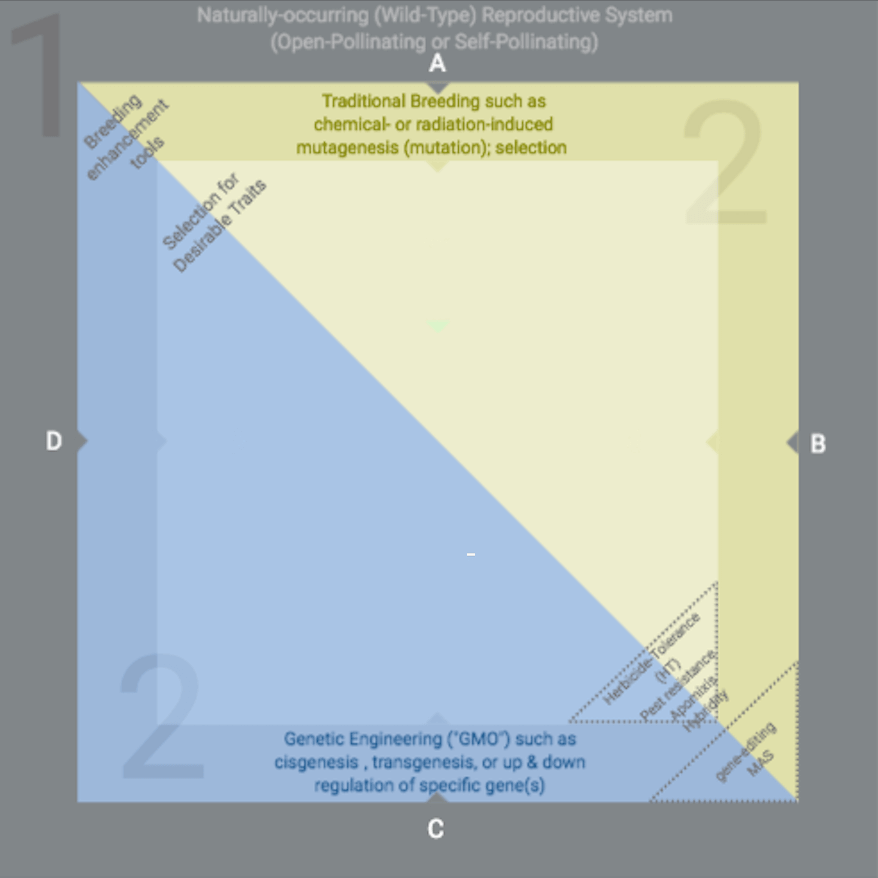
This part is super interesting, because herbicide tolerance (HT) traits are commonly assumed to always be GMO, but actually they can be established in plants via either traditional breeding, or applying GMO techniques (genetic engineering). HT gives the crop the ability to go unaffected after being sprayed by a specific herbicide which would otherwise kill it.
I’ll use canola as an example again here. There are three main categories of HT canola: glufosinate-resistant (GF), glyphosate-resistant (GP), and imidazolinone-resistant (IMI). All are HT, all have functional differences relative to the wild type progenitor, however GF and GP are “GMO” while IMI is not “GMO” since it was established via traditional breeding. In other words, a couple transgenes were deliberately introduced into parent plants chosen from the starting pool (the grey square) giving the GF and GP varieties this HT ability; in contrast, mutagenesis was used for the starting material in preceding generations for the IMI non-GMO varieties. Mutagenesis involves exposing the population to a mutagen that deliberately induces random mutations (genetic disruptions, resulting in new or different traits) in individuals of the population, from which those with ideal traits (including HT) are selected and further generations are derived from those ones. The mutagen agent is of course not carried forward in subsequent generations, but the resulting mutations (and thus resulting traits) are.
3) Field production
This next part is the third major phase of this concept: field production. This is the part where you see farm equipment operating in the field each year. There are two production methods that farmers can choose: conventional, or organic (but the decision will have been made months before planting and/or before acquiring seed). Conventional is a general category referring to the most modern technology (in crop production, or with field equipment), whereas “organic” is a technical term described in the Organic Products Regulations within the Canada Agricultural Products Act.
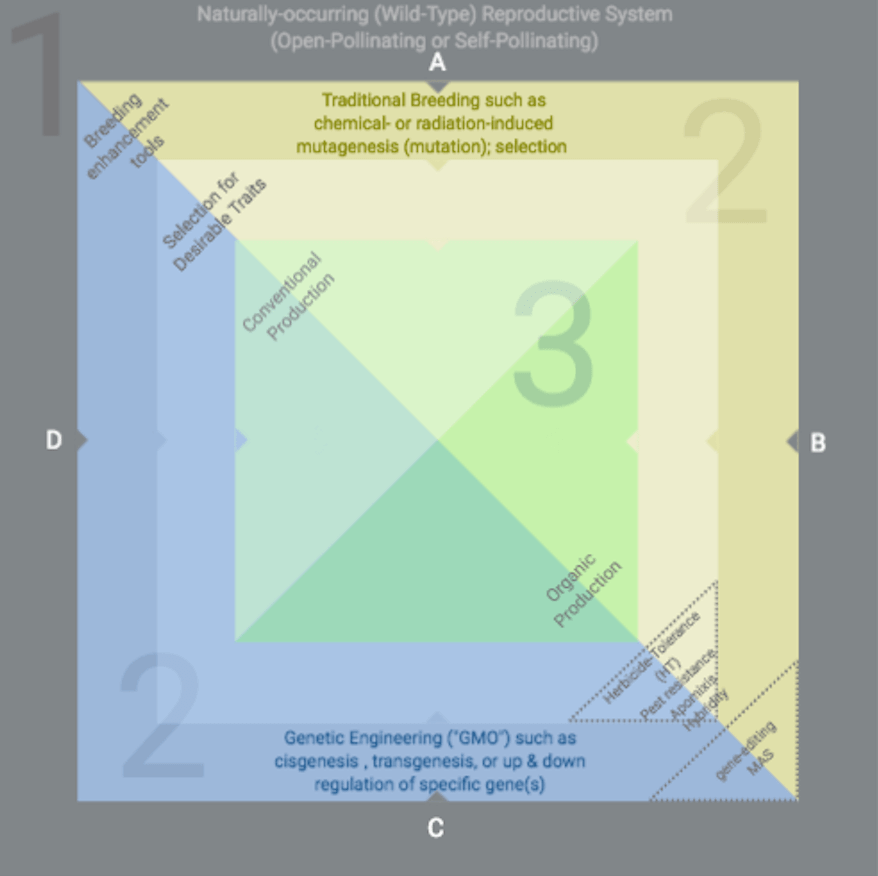
Now keep in mind this is technically speaking: put viable seeds in the ground, and they will grow; the field conditions don’t really care about whether generations previous to that seed were bred using traditional or genetic modification techniques. This is why the green representing field production practices overlaps with both breeding approaches. Here’s that section outlined in the line-dash:
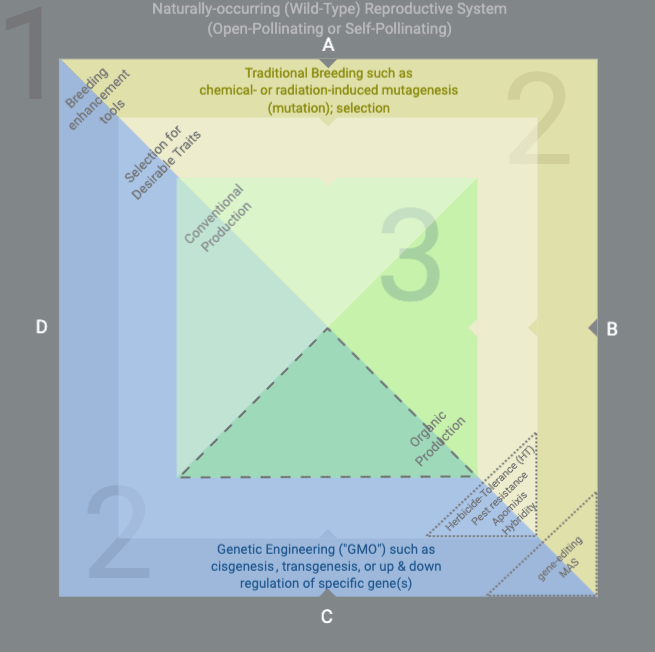
But, because this is regulation (i.e. power of law), this is the part where the value chain becomes somewhat incongruent with technical realities. Remember the chronological order in which these events must all happen. Up to this point, everything follows a logical flow, but suddenly one of them (the dark green, outlined shaded area) is backwards.
Why is“organic” a distinct and regulated term.
In Canada, section 1.4 of Organic production systems: General principles and management standards clearly prohibits “materials or techniques in organic production and preparation…all products of and materials from genetic engineering (GE), as defined in this standard, and as specified in 4.1.3, 5.1.2 and 6.2.1 of CAN/CGSB-32.311;”. This is current as of March 2021. It defines genetic engineering to produce GMOs as “artificial manipulation of living cells for the purpose of altering its genome constitutes genetic engineering and refers to a set of techniques from modern biotechnology by which the genetic material of an organism is changed in a way that does not occur other than through traditional breeding by multiplication or natural recombination.” The genome is considered an indivisible entity; artificial technical/physical insertions, deletions, or rearrangements of elements of the genome constitute genetic engineering.
Lastly, let’s address pesticides. This is the final square overlay.

Neither contemporary systems are perfect in this context, since there are a plethora of pesticides approved for both conventional and organic systems. Of course, toxicology will differ for each but regardless, for registration and use in Canada, they are all subject to the same extensive regulatory process of the Pest Management Regulatory Agency (PMRA) of Health Canada.
Now, look at the four letters labelling the pathways around the sides (A, B, C & D). All three, A, B, and D are technically possible, and “allowed.” But look at path C: plants are bred from the starting pool using genetic engineering techniques, and could very well be grown in the field with organic production methods, since production occurs after the genetics are established in a variety. Sure, you could argue there would be no point to doing that, if the assumption was that all GMO traits are herbicide tolerance, and thus to benefit from the modifications, the appropriate herbicide must be applied. However, HT is only one of many real and theoretical traits that can be conferred to an oRgaNiSm.
One last layer: A sub-category of conventionally-produced crops are those with a herbicide tolerant (HT) trait and thus a specific herbicide is to be used in the field with them.

This concept was already introduced earlier at the trait selection step in the 2nd phase of this process. To date, there are only HT varieties compatible with conventional production of GMO varieties + application of conventional herbicides (path D), and conventional production of non-GMO varieties + application of conventional herbicides (path A). Technically, path B could be possible and permitted under current regulation, assuming there were an organically-approved herbicide to which the crop variety were tolerant, but I’m unaware of any. And HT under path C of course can never be reached within current regulation.
It’s a bit tricky to depict in an illustration. to select for a trait that confers herbicide tolerance, the plants at that step of the breeding process have to be exposed to a specific herbicide (when the herbicide to be used is already defined) or to be exposed to a spectrum of different herbicides (different chemistries)
Let’s put it all together. Here’s the full illustration with all the details added:

And guess what: the fundamental genetic ‘building blocks’ are identical whether the plant is GMO or not. Whether you’re eating the plant’s carbohydrates, proteins or fats, the body therefore isn’t concerned about how they were assembled. Either the material is digested / broken down and used in the body, or dissembled and excreted and eventually becomes ‘fertilizer’ for more things to grow, thus adding to the…
Is it likely that “organic GMOs” will become commonplace?
Considering the information presented on the Canada Organic Trade Association (COTA), the national association which “… protects, promotes and builds information on Canada’s organic sector,” it is vehemently opposed to anything GMO, stating that “Genetically engineered products (GMOs) are prohibited in organic production. This means an organic farmer can’t plant GMO seeds…” Actually, I can get on board with most of what they actively promote, let’s take a look:
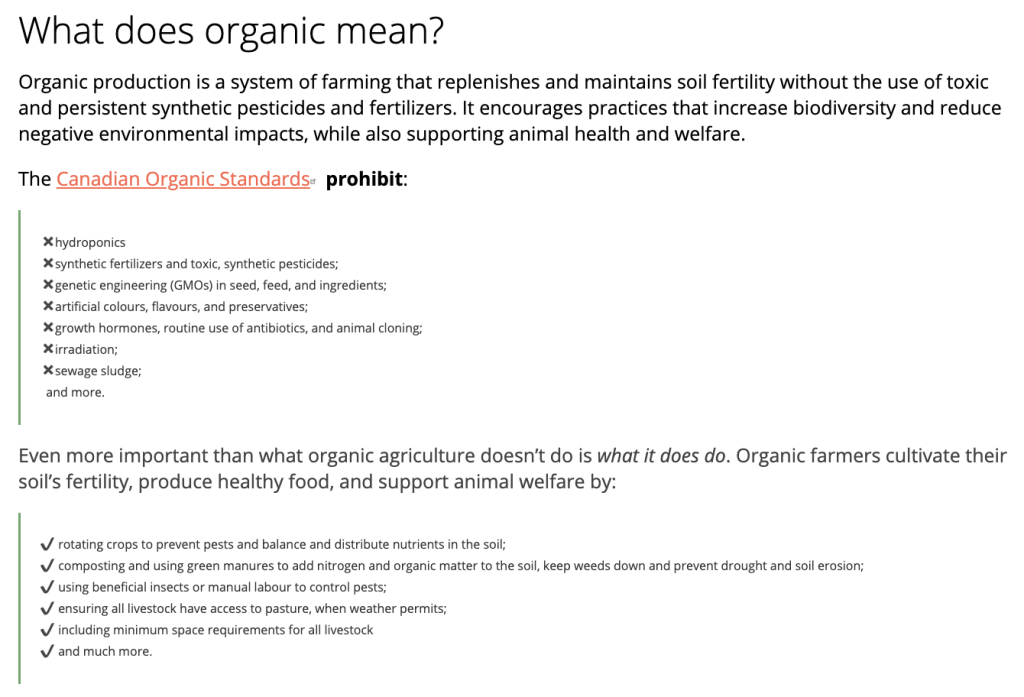
While these are mostly noble goals, the opposition to GMOs is over-reaching and not well founded, as it rejects genetically engineered solutions with identical goals. I suppose it makes sense for an organics association to dictate what/what type of pesticides can be used to establish a specific production environment, but for the same association to take any stance on GMOs is inappropriate. I am not saying safety/practicality/feasibility of genetic engineering should not be assessed; rather, I am saying that should be an independent association/effort rather than distorting interest via the lens of a specific production system.
Genetic engineering is already used to significantly reduce the use of “toxic and persistent synthetic pesticides and fertilizers” while encouraging biodiversity. Consider Bt crops In this case, one gene from a bacteria (Bacillus thuringiensis, Bt for short – originally registered in the USA 60 years ago as a biopesticide) that is naturally found in soil was genetically engineered into a corn variety’s genome (and subsequently into other crops including soybeans, cotton and eggplant). Why? That gene enabled the bacteria to produce a protein that was naturally (and selectively) an insecticide to a particular insect that happens to be a pest to the corn. Instead of spending time, money, and fuel to spray a synthetic insecticide across entire fields, this modification gave the corn inherent ability to repel that insect. Bt crops eliminate the need to spray to kill insect pests, minimize pest-related crop losses and reduce the financial risks—all by using tools already in that environment.
Bt corn was the first insect resistant crop rolled out, in 1995 in the United States. The seeds are now grown in many countries around the world.
Bt crops—whether corn grown in the Canada or South Africa or Brazil, or Bt eggplants grown in Bangladesh — have led to a dramatic drop in the use of chemical pesticides.
Other benefits
Organic GMOs will become increasingly relevant in the next few years, not only to comply with global efforts to reduce pesticide use, but for reasons unrelated to pesticides.
Here are a few intriguing non-human-nutrition-focused benefits that GMOs could offer, assuming their progress isn’t further impeded. Over the past couple decades, they have helped to reduce pesticide (herbicide and insecticide) and indirectly reduced greenhouse gas emissions. Recent efforts are investigating the ability to modify plants (trees, maybe field crops soon) to reduce carbon emissions by increasing their capacity to store carbon in their root systems. They hint at other modifications to improve their amenability to processing for biofuel use as well, further adding to efforts to reduce GHG emissions. Other groups believe GMOs are essential to quickly adapting commercial crop varieties for extreme environmental changes, such as drought, or even to produce ‘no-carbon‘ fuel. Check out Singapore’s Gardens by the Bay, one of many “futures” that agriculture could take.

Such technologies to combat field pests isn’t perfect; some populations of the target pest can eventually overcome the crop’s inherent insecticidal ability – note that this is not unique to insects nor to genetic engineering solutions to pests. There are greater implications beyond the scope here, but briefly, implies how crucial crop rotations are (in other words, removing continuous availability of hosts), as well as taking an integrated approach to production (switching up the tools used to combat pests, and/or using 2 or more tools at once).
Another valid concern raised is that crops modified to endogenously produce pesticides means that it is dispersed throughout the plant & thus the parts that are processed for food. If prohibition of this area of research were to end, I would anticipate that the end-products would be subject to the same extensive Health Canada regulations as “food additives” currently are.
To reiterate: I’m not saying this is an all-or-nothing scenario, or that GMOs offer all the answers. But these technologies and systems should be more integrated and be given more consideration as complementary rather than viewed as competition. The rapidity with which environments have changed in recent history I would think is even more reason to put all options on the table. When has prohibition of anything ever been effective?
Questions to ponder
- Is human-directed plant breeding – GMO or not – the opposite of “natural”?
- Or, since humans are also an evolved part of nature, is this simply the next step in natural selection and we are a conscious component of the entire natural environment imposing selection pressure?
- If organic GMO options were to be offered in a grocery store at a price point between current prices for organic and non-organic, would you buy it? Are GMOs viable considerations to effectively addressing global issues such as climate change?
- Should the same ‘rules’ apply to plants being used for food, as for industrial (non-food) use?
The purpose of this article is not to declare anything as right or wrong, good or bad, best or worst; rather, it is to help non-specialists understand technical nuances and offer some new information to ponder, or cause some progressive discussion among industry. Hopefully in some way, it might help guide a more progressive, rational, sustainable and/or profitable industry. Nothing here is sponsored; it is simply my own view on current and future directions that agriculture may take.
A version of this article was originally posted at the Former Farmboy and is reposted here with permission.





































